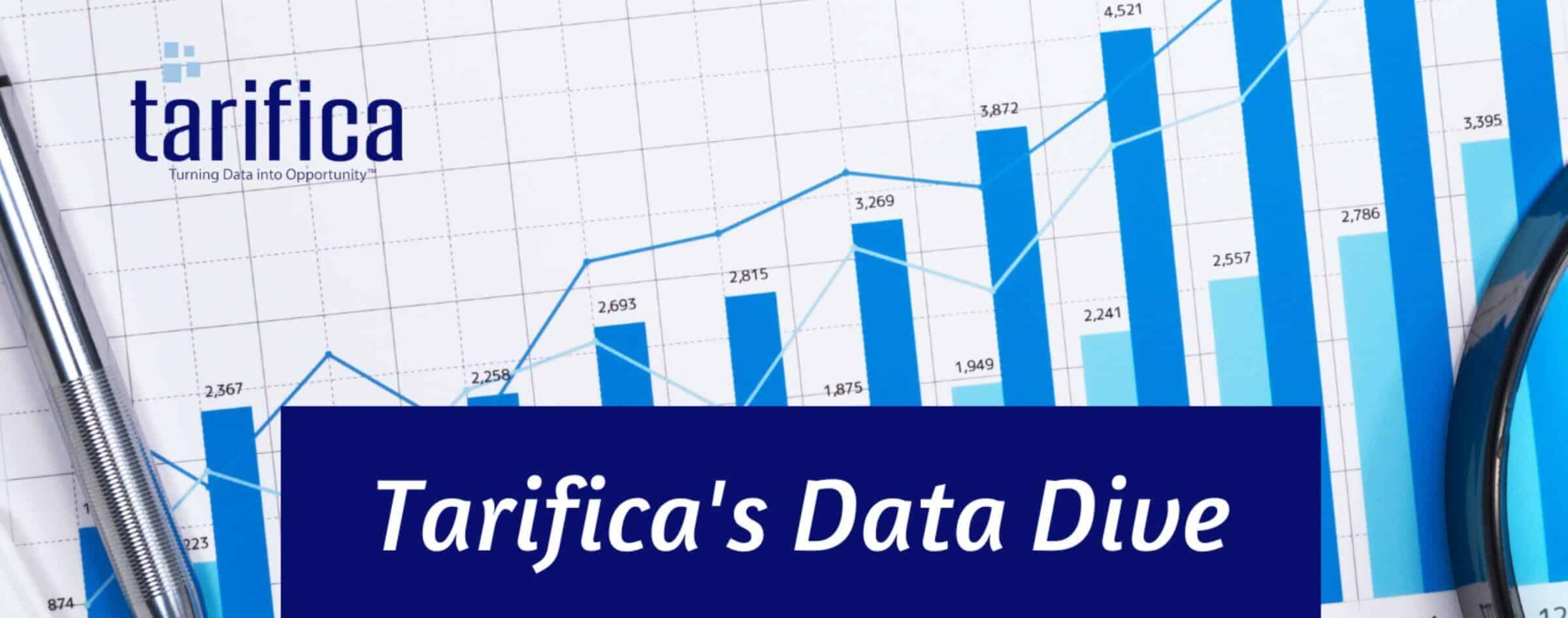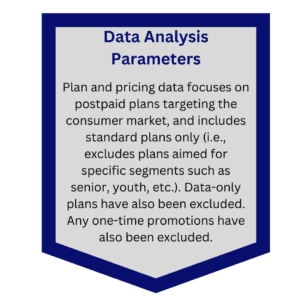
Tasting the Spectrum: The Flavors of 5G Premium Pricing
by Soichi Nakajima
In the September edition of Tarifica’s Data Dive, our analysis revealed a pivotal shift–5G plans now largely outnumber non-5G plans in the marketplace. In some regions, the transition to 5G is so complete that every plan includes 5G by default. Delving deeper, our data uncovered intriguing patterns in 5G premium pricing.
For this month’s edition, we took a closer look at the variations in each country’s approach to pricing 5G:
- Do premium values for 5G differ across countries?
- How do data inclusions and pricing variations play out?

To tackle these questions, we examined plan and pricing data collected for 17 countries from Tarifica’s proprietary Telecom Pricing Intelligence Platform (TPIP). We used the “rational consumer” methodology to ensure an apples-to-apples comparison: focusing on the least expensive postpaid, standard, consumer 5G plan in each country and comparing it with its non-5G counterpart with similar data inclusion.

Mapping the 5G Premium Landscape
Our analysis revealed four distinct groups, categorizing countries based on whether one pays more or less for 5G connectivity, along with whether one receives more or less data. This categorization has been mapped onto the matrix below.

Visualizing the data in this way allows us to identify three key findings:
- Price Premium Insights.
The 5G premium typically falls in the 50-60% range, accompanied by instances where users pay more for 5G but receive decreased data allowances, despite the increase in price. - Negative Premiums:
There are markets where the premium value for 5G can be classified as negative. In other words, in these countries, users actually end up paying less for a 5G plan than they would for a non-5G plan. - Default 5G:
There are countries where 5G is not a premium feature at all, but rather come standard with all plans, with no differentiation in the technology. This challenges conventional expectations.
The 5G Pricing Groups
The following section provides an example country for each of the groups.
Group 1: Standard 5G Premium – Pay More for Optional 5G Access

Perhaps the easiest group to conceptualize, countries in Group 1 (Australia, France, Ireland and Poland) require subscribers to pay an extra fee for accessing 5G with all other characteristics remaining the same. For example, French users have the option of paying an extra EUR 3.00 per month for 5G access.
The premium for 5G access in Group 1 countries is anywhere from 20% to 80% higher than their non-5G counterpart plans, adding between EUR 3.00 and EUR 8.50 to customers’ monthly bills.
Group 2: High 5G Premium – Pay More for 5G Access While Getting Less Data

Subscribers in Group 2 countries (Canada, Italy and the Netherlands) pay the highest prices for 5G access, yet receive less data in the bargain. In Canada, for example, the premium for 5G access amounts to a 50% price increase, while the amount of data received is 25% less than what is offered in the comparable non-5G plan.
In fact, subscribers in all three countries’ markets pay a premium for 5G access that amounts to around a 50% price increase over non-5G plans. At the same time, however, they see data volumes at anywhere from 25% to 50% less than they would have received with a non-5G plan.
Group 3: Low 5G Premium, But Promos Affect Value

For Group 3 countries (Germany and Singapore), promotional offers make all the difference in the value of 5G data.
Before any promotions are applied, the increased price for 5G is accompanied by an increase in data volume. As a result, the premium value of 5G in Group 3 countries is initially lower than in the other groups, because the price increase includes 5G network access and the increased data volume. For example, in Germany, the 5G plan costs 50% more than the non-5G plan, but the data volume for the 5G plan is two-thirds higher than for the non-5G plan.
However, once promotions are applied to non-5G plans, their data volumes increase, giving them more data than the 5G plans, without changing the price. So in the exmaple above, the 5G plan still costs 50% more, but its data volume ends up being 20% less than what is offered in the non-5G plan.
The premium for 5G amounts to approximately a 50-60% price increase across both countries in Group 3. However, the promotions alter the value of 5G data for Group 3 such that it becomes more similar to Group 1, in which users are paying more for 5G access while other plan features remain generally constant.
Group 4: Negative 5G Premium — Pay Less for 5G Access

This final group (including Belgium, Estonia and the UK) may come as a surprise, but there are, in fact, countries where users can find a 5G plan for the same price, or even cheaper than, a non-5G plan with the same amount of included data. In the above example, we see the lowest 5G plan in Belgium whose price and data volume are identical to its non-5G counterpart.
This happens in markets where 5G providers (mostly MNOs) offer 5G access for their lowest-end plans, with as little as only a few GB, which forces alternative providers (MVNOs) to go even lower on price and inclusive data in order to compete. That said, before promotions, the value of 5G and non-5G plans in Group 4 is roughly equal.
Group 0: 5G as Baseline
The remaining countries form what we have called Group 0. These countries (Denmark, Japan, New Zealand, Spain and the USA) currently offer 5G connectivity by default for all standard plans. Therefore, it’s not possible to make a comparison between 5G and non-5G plans for this group.
The MVNO Effect
The unique pricing dynamics observed in Groups 3 and 4 can be attributed to the significant influence of MVNOs. Unlike markets in Groups 1 and 2, where 5G access if often reserved for high-paying subscribers, MNOs in Groups 3 and 4 have adopted a more aggressive approach, extending 5G access to even their lowest-end plans. This puts MVNOs in a position that compels them to further reduce prices or offer higher data volumes at a lower cost to remain competitive.
The data landscape described above highlights this stark contrast, with Groups 1 and 2 boasting data volumes of 15GB to 20GB for their cheapest plans, while the least expensive plans in Groups 3 and 4 hover between 3GB and 6GB. This phenomenon underscores the fierce competition in Groups 3 and 4, where, MNOs having extended 5G access to all plan tiers, MVNOs strive to attract customers with lower prices or more data, albeit without 5G access. In essence, MNVOs in these groups play a pivotal role in shaping the pricing and data value dynamics for these two groups. However, they also create an unexpected pricing environment which appears to be driving consumers toward non-5G plans, despite the current trend encouraging 5G adoption in developed markets.
Conclusion
As we conclude this edition of Tarifica’s Data Dive, and our exploration into the complexities of 5G pricing, the data reveals a nuanced landscape defying conventional expectations. Applying the rational consumer methodology to compare 5G and non-5G offers, we were able to see how the premium value attached to 5G connectivity can vary across markets.
In Group 3, we saw how promotions impacted the value of 5G data, while the MVNO Effect added an intriguing layer to the pricing dynamics in Groups 3 and 4, defying the conventional wisdom. We also saw that while many countries place a significant premium on 5G access, in some markets there is no premium attached to 5G at all.
The telecom market, much like a well-composed piece of music, echoes with diverse notes across different countries. As we anticipate the future echoes of 6G, our continued journey with our Tarifica’s Telecom Pricing Intelligence Platform will ensure we stay attuned to the evolving symphony of 5G dynamics, always listening for the subtle shifts in the telecommunications melody.

About the Author:
Soichi Nakajima
VP Data and Analysis
snakajima@tarifica.com
With over 20 years of telecommunication market analysis experience, Soichi oversees the data collection, quality, research, analysis, and production of all data projects and quantitative studies.
For questions or comments about this analysis, please contact Penny Wiesman at pwiesman@tarifica.com